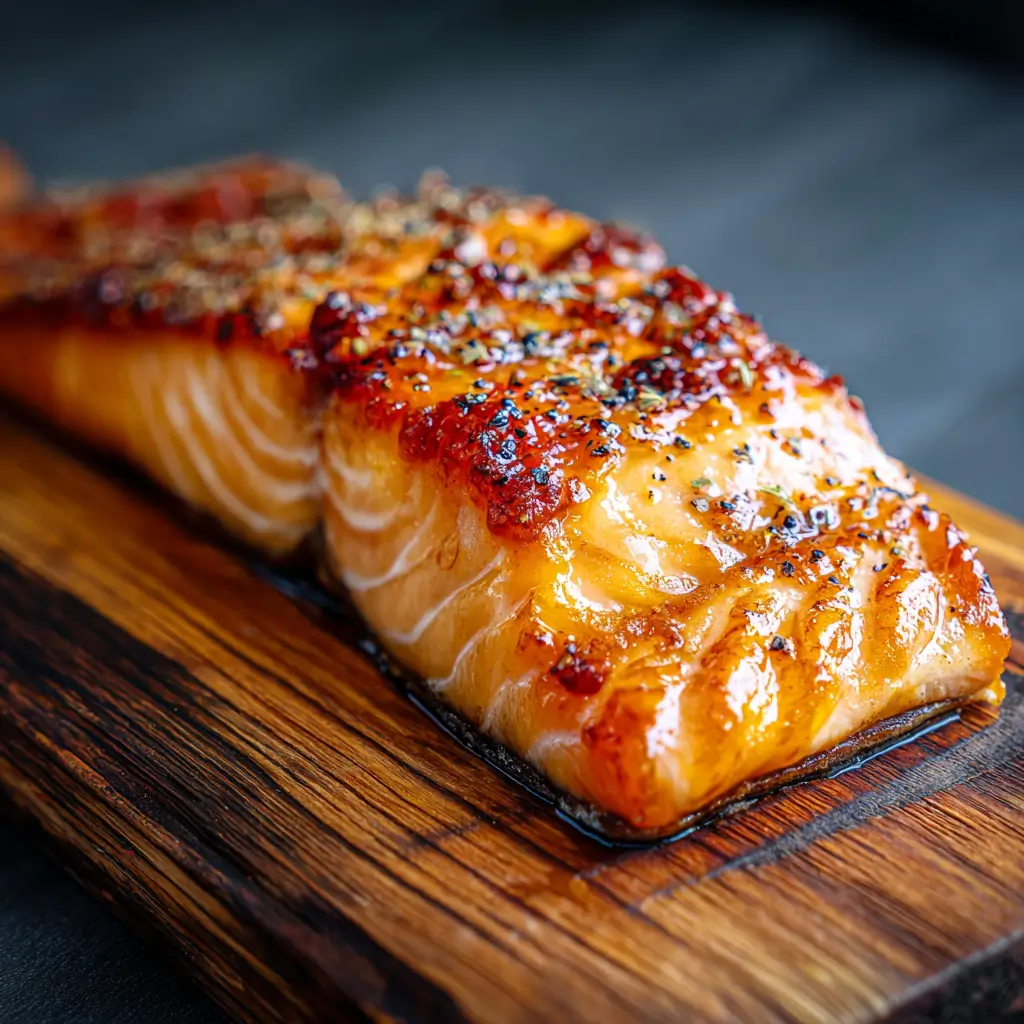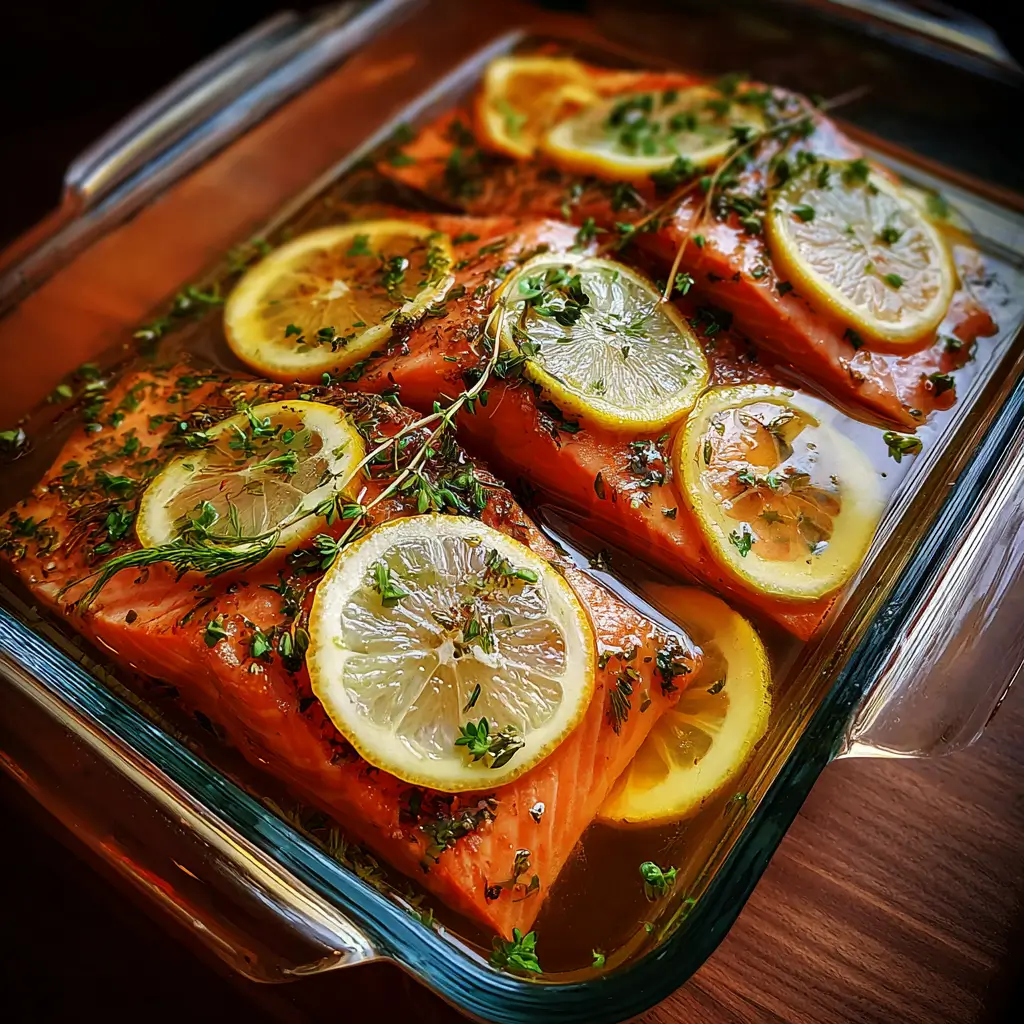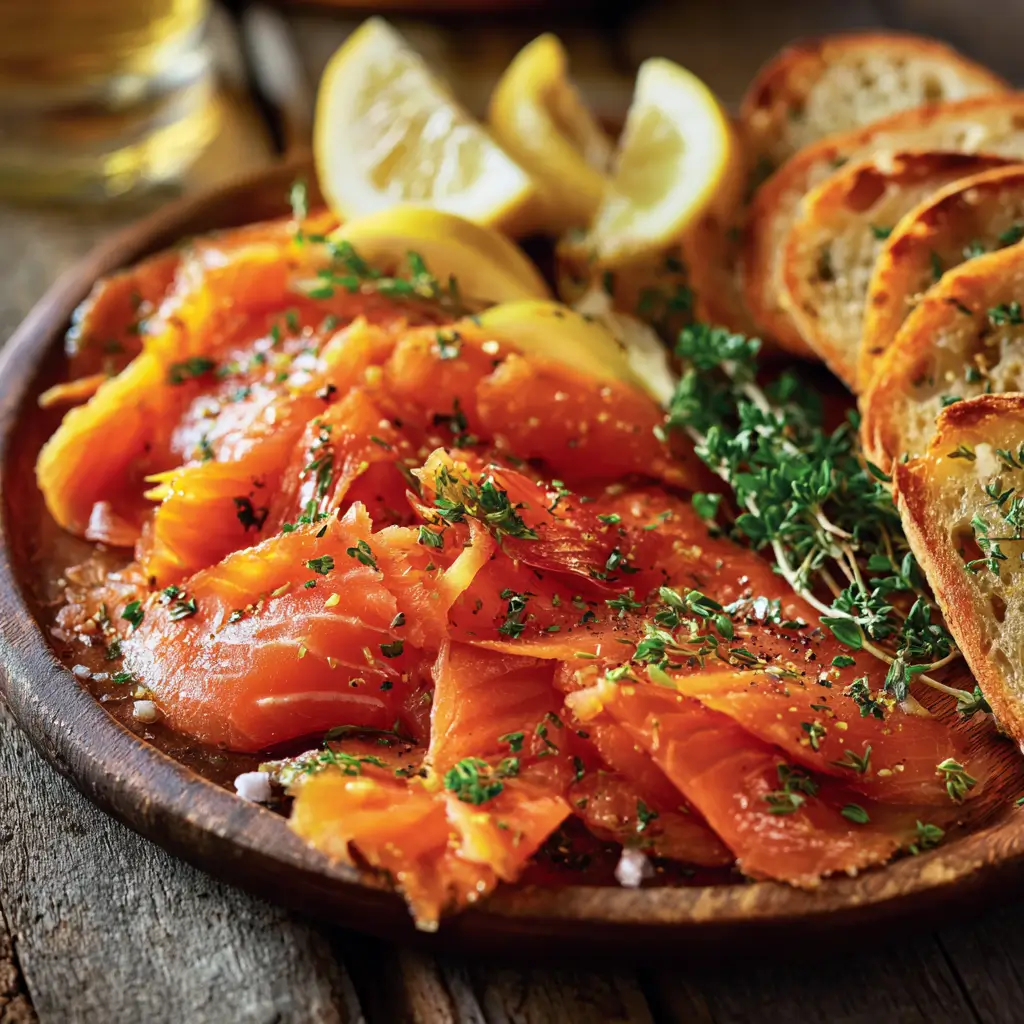Maple wood for smoking salmon brings out the best in this delicate fish, adding a gentle sweetness that turns every bite into something special. The mild smoke from maple enhances the salmon’s natural richness without overwhelming it, creating that perfect blend of savory and sweet that so many smoked salmon lovers crave.
Compared to stronger woods like hickory or mesquite, maple wood for smoking salmon delivers a smoother, more balanced flavor. Its subtle sweetness and soft aroma give the fish a golden, caramelized finish that feels refined yet comforting. That’s why many home cooks call maple one of the best sweet woods for smoking fish.

If you enjoy experimenting with flavor, try pairing maple smoke with a light brown sugar brine or a maple mustard rub—it highlights the fish’s buttery texture while adding depth. Learn more about how to smoke salmon at home in our detailed guide: How to Smoke Salmon at Home.
Join our community on Facebook and find new inspiration for smoked fish boards on Pinterest.
In the next section, we’ll explore what makes maple wood for smoking salmon so special—its characteristics, smoke intensity, and how it compares with other popular woods like hickory and alder.
Table of Contents
Understanding Maple Wood for Smoking Salmon
Why Maple Wood Works So Well for Smoking Salmon
Maple wood for smoking salmon is prized for its gentle, sweet smoke that enhances the fish’s natural richness without overpowering it. Unlike strong hardwoods like hickory or mesquite, maple burns clean and slow, creating a mild aroma that gives salmon a smooth, caramelized finish. The flavor is subtle, balanced, and comforting—perfect for anyone who wants a light smoky sweetness rather than a bold char.
Flavor and Versatility
What makes maple wood for smoking salmon so special is its versatility. Its soft smoke pairs beautifully with a variety of brines and rubs, especially those featuring brown sugar, mustard, or citrus. This balance lets the maple’s sweetness highlight the salmon’s buttery texture, producing that golden glaze home smokers love.
Maple vs. Other Woods
Compared to hickory or mesquite, maple provides a gentler touch, while still adding depth. It’s also slightly stronger than alder or apple, giving the fish more warmth and complexity. For fatty salmon like king or Atlantic, maple adds sweetness without turning bitter—a perfect middle ground between light and bold woods.
Check out more expert comparisons in our guide: Best Wood for Smoking Salmon.
Preparing Your Salmon for Maple Smoking
Choosing the Right Cut for Maple Wood Smoking
To get the best results when using maple wood for smoking salmon, start with the right cut of fish. Fatty salmon varieties like king, coho, or Atlantic absorb the mild, sweet smoke beautifully. Their rich oils hold onto that gentle maple flavor, creating a perfectly balanced taste. Always choose fresh salmon with a firm texture and vibrant color—both signs of quality that ensure the smoke will enhance, not mask, the fish.
Brining Before Smoking with Maple Wood
Brining is the secret step that helps maple wood for smoking salmon work its magic. A well-balanced brine locks in moisture while deepening the smoky-sweet flavor. Mix cold water, salt, brown sugar, and a drizzle of maple syrup for a simple yet effective base. The syrup complements the natural sweetness of the maple smoke, producing a flavor that feels rich but never heavy.
Let your salmon soak in the brine for 6 to 8 hours, depending on thickness. Afterward, rinse and pat dry. Before it hits the smoker, allow the fish to air-dry until a thin, tacky layer forms. This pellicle helps maple wood for smoking salmon cling evenly, ensuring every bite carries that sweet, smoky depth.
Seasoning That Complements Maple Smoke
When you use maple wood for smoking salmon, choose seasonings that highlight its delicate flavor rather than hide it. A dry rub made with salt, brown sugar, garlic powder, and a hint of mustard or dill works wonderfully. These ingredients caramelize gently during smoking, creating a flavorful crust that pairs perfectly with maple’s natural sweetness.

Check out our Smoked Salmon Rub Recipe for a blend that enhances the smooth, sweet flavor of maple wood for smoking salmon.
Smoking Techniques with Maple Wood
Preparing Maple Wood for Smoking Salmon
Getting the best flavor from maple wood for smoking salmon starts with how you prepare your wood. Use high-quality maple chunks or chips—avoid treated or green wood, which can produce harsh, acrid smoke. If you’re using chips, soak them in water for 30 minutes before smoking to help them smolder slowly and release that sweet, steady smoke maple is known for.
When the wood starts to smoke, you’ll notice a clean, light aroma with a hint of caramel. That’s when the magic begins. The mild, even burn of maple ensures your salmon absorbs flavor gradually, preventing it from drying out while building that smooth, amber-colored crust.
Temperature and Time Control
Consistency is key when using maple wood for smoking salmon. Keep your smoker between 150°F and 175°F (65°C–80°C) for hot smoking or 80°F–90°F (27°C–32°C) for cold smoking. Maple burns evenly, so maintaining steady heat is easier than with stronger woods like hickory.
If you’re hot smoking, aim for 2 to 3 hours depending on the fillet’s thickness. For cold smoking, plan for up to 8 hours of gentle exposure. Remember: with maple wood for smoking salmon, slow and steady always wins—the longer exposure enhances sweetness while maintaining tenderness.
Enhancing Flavor During the Smoke
You can boost maple’s natural sweetness by brushing the salmon lightly with maple syrup or honey halfway through smoking. This creates a glossy glaze and deepens the flavor. Avoid opening the smoker too often, though—heat loss can interrupt the even smoking process and dull the maple aroma.
For the best flavor consistency, combine maple wood for smoking salmon with a secondary wood like alder or cherry. The mild fruit notes complement maple’s sweetness perfectly.
Don’t miss our detailed guide on Salmon Smoking Temperature for step-by-step heat control tips.
Maple Wood Pairings and Complementary Flavors
Balancing Sweetness and Savory Notes
When you use maple wood for smoking salmon, the goal is balance—sweet smoke meets savory richness. Maple’s natural sweetness complements the fish’s buttery texture, so pairing it with the right brines and rubs creates an irresistible depth of flavor. The key is contrast: a touch of salt, spice, or citrus brings the maple’s warmth to life.
For example, a dry rub made with brown sugar, garlic, and a pinch of black pepper caramelizes beautifully under maple wood for smoking salmon. The sugar mirrors the smoke’s sweetness, while pepper and salt keep it from tipping too far into dessert territory.
Perfect Flavor Partners for Maple-Smoked Salmon
To highlight maple’s smooth profile, think in layers. Start with a mild brine—water, sea salt, and a bit of maple syrup—to build base flavor. Next, apply a glaze featuring mustard, lemon zest, or even soy sauce for a savory counterpoint. These small touches make the smoke’s sweetness stand out without overpowering the dish.
Citrus-based glazes or maple-mustard rubs work especially well with the light caramel aroma from maple wood for smoking salmon. You can even sprinkle fresh dill or thyme after smoking for a herbal accent that lifts the richness.
Enhancing Flavor with Maple-Based Rubs
One of the most popular ways to deepen flavor is through a maple mustard smoked salmon rub. This rub combines mustard’s sharpness with the wood’s subtle sweetness for a restaurant-quality finish. You can find an easy-to-follow version here: Maple Mustard Smoked Salmon Rub.
This combination captures everything special about maple wood for smoking salmon—a hint of sweetness, balanced with warmth, spice, and a silky texture that melts in your mouth.
Maple Wood vs. Hickory and Other Smoking Woods
Maple vs. Hickory for Salmon
When it comes to maple wood for smoking salmon, one of the most common questions is how it compares to hickory. Both woods are classics for smoking, but their flavors couldn’t be more different. Hickory offers a bold, almost bacon-like smokiness that can easily overpower delicate fish if used heavily. Maple, on the other hand, produces a smoother, gentler smoke with a hint of sweetness that complements salmon rather than masking it.
If you prefer mild, caramelized undertones and a clean aftertaste, maple wood for smoking salmon is the better choice. Hickory shines when you want intensity and depth, but for most home smokers, maple delivers a more balanced and approachable flavor.
Maple vs. Alder, Apple, and Cherry Woods
Alder is another popular choice for fish, especially in the Pacific Northwest. It burns clean and produces a very light smoke, ideal for those who want minimal sweetness. Apple and cherry woods add fruitier notes that can complement salmon, but their flavor tends to be lighter and less robust than maple.
Compared to these, maple wood for smoking salmon offers the perfect middle ground—it’s more flavorful than alder but softer than hickory, with a mellow sweetness that works beautifully in both hot and cold smoking. It also produces a rich golden hue that other woods can’t quite replicate.
Best Scenarios for Maple Wood
Maple shines when you want a sweet-smoked salmon that pairs well with glazes, citrus, or light herbs. It’s ideal for smoked salmon boards, brunch dishes, or recipes where presentation and balance matter. Because maple smoke isn’t overwhelming, you can safely pair it with delicate toppings like cream cheese, capers, or dill without clashing flavors.
For more in-depth comparisons, check out our guide on Alder Wood for Smoking Salmon to see how each wood type performs.
The Smoking Process Step-by-Step (Using Maple Wood)
Step 1: Prepare Your Smoker and Maple Wood
To get the most from maple wood for smoking salmon, start with the right setup. Use clean, dry maple wood chunks or chips—avoid sap-heavy or treated wood, which can add bitterness. If you’re using chips, soak them for about 30 minutes to encourage slow smoldering. For pellet smokers, choose 100% maple pellets for a consistent, mild burn.
Preheat your smoker to around 160°F–175°F (70°C–80°C) for hot smoking. This temperature lets maple wood for smoking salmon release its gentle, sweet smoke slowly, ensuring deep flavor without drying the fish.
Step 2: Arrange the Salmon Properly
Place your brined and seasoned salmon skin-side down on the smoker rack. This keeps the fish moist while the smoke penetrates evenly. Avoid overcrowding—good airflow ensures even smoking and prevents bitter smoke buildup.
During the first hour, resist the urge to open the lid. The maple smoke needs time to circulate and cling to the fish’s surface. Remember, maple wood for smoking salmon produces a softer smoke, so patience is key for achieving that beautiful amber glaze.
Step 3: Monitor Temperature and Smoke Flow
Keep a close eye on both internal and smoker temperatures. Salmon is done when it reaches 140°F (60°C) at the thickest part. Maintaining steady heat and clean smoke ensures that the sweetness of the maple stays pure. White, wispy smoke is ideal—thick gray smoke can make the fish taste bitter.
To enhance flavor, lightly brush your salmon with maple syrup during the final 30 minutes. This step amplifies the caramel tones of maple wood for smoking salmon, giving the fish a glossy finish that looks as good as it tastes.
Step 4: Rest and Serve
Once smoked, let the salmon rest for about 10 minutes before serving. This allows the juices to redistribute and the smoke flavor to settle into the meat. You’ll notice a perfect balance—sweet, savory, and smoky all at once.
Don’t miss our complete DIY Smoked Salmon Guide for extra tips on cooling, storing, and slicing your finished maple-smoked salmon.
Maple Smoked Salmon Recipes and Serving Ideas
Classic Maple Smoked Salmon Recipe
A traditional recipe using maple wood for smoking salmon is as simple as it is satisfying. After brining and drying your salmon, smoke it low and slow over maple wood until tender and flaky. During the last half hour, brush it with a thin layer of maple syrup mixed with Dijon mustard. This glaze deepens the caramel notes from the wood, giving the fish a subtle sweetness and shine that looks incredible on the plate.
Creative Ways to Serve Maple-Smoked Salmon
One of the best things about maple wood for smoking salmon is its versatility—it fits beautifully into a variety of dishes. For brunch, serve thin slices of maple-smoked salmon with bagels, cream cheese, and capers. The mild sweetness pairs wonderfully with tangy spreads. For lunch or dinner, toss it into a salad with mixed greens, citrus segments, and toasted almonds. The smoke and sweetness complement the freshness perfectly.
Feeling adventurous? Use maple-smoked salmon in pasta, sushi rolls, or even deviled eggs for a unique twist. The gentle smoke flavor elevates everyday recipes into something gourmet without being overpowering.
Pairing Maple-Smoked Salmon with Drinks and Sides
The mild, sweet tones of maple wood for smoking salmon pair best with light, refreshing drinks. Try a crisp white wine, a wheat beer, or a sparkling cider to balance the richness of the fish. On the side, go for roasted vegetables, herbed rice, or a citrus-forward salad to brighten the flavors.

For more creative inspiration, discover great ideas like our Salmon Poke Recipe, which you can adapt with maple-smoked salmon for a sweet-savory fusion.
Common Mistakes When Using Maple Wood for Smoking Salmon
Using Too Much Smoke
One of the biggest mistakes people make with maple wood for smoking salmon is using too much wood. Maple produces a gentle, sweet smoke, but overdoing it can make the fish taste bitter or overly dense. The trick is moderation—just enough wood to enhance, not dominate, the salmon’s natural flavor. You want thin, blue-white smoke, not thick gray clouds.
When smoking for several hours, add small amounts of maple wood for smoking salmon gradually to maintain a clean burn. Remember, salmon absorbs smoke quickly, so a little goes a long way.
Ignoring Temperature Control
Temperature is everything when working with maple wood for smoking salmon. Too high, and the sugars from the maple will burn; too low, and the fish won’t absorb enough smoke. Keep your smoker between 160°F and 175°F for hot smoking and use a reliable thermometer to monitor internal heat.
If your salmon starts turning dark too quickly, you may be burning your wood rather than letting it smolder. Adjust airflow or reduce wood quantity to get that ideal, sweet-smoke flavor.
Skipping the Drying Step
Another common oversight is skipping the pellicle stage—the brief drying period before smoking. Without it, the smoke from maple wood for smoking salmon won’t stick properly, leading to uneven flavor and texture. Letting your salmon air-dry for at least an hour ensures a silky finish and that signature amber sheen.
Overpowering the Flavor with Strong Marinades
While it’s tempting to go bold with seasonings, strong marinades or spicy rubs can mask the gentle sweetness that maple wood for smoking salmon provides. Keep your ingredients balanced—simple salt, sugar, and light herbs bring out maple’s natural warmth.
Don’t miss our guide on How Long to Smoke Salmon to fine-tune your timing and avoid over-smoking.
FAQs
Is maple good for smoking salmon?
Yes, maple wood for smoking salmon is one of the best choices you can make. Its smoke is light, sweet, and clean, adding a caramel-like flavor that enhances the salmon’s natural oils without overpowering them. Maple’s medium density allows for slow, even smoking, which produces a golden, gently glazed finish that’s perfect for any recipe.
What’s the best wood for smoking salmon?
The best wood depends on the flavor you want. For mild, slightly sweet results, maple wood for smoking salmon is ideal. If you prefer something bolder, hickory adds deep, smoky richness, while alder gives a delicate, neutral smoke. Many pitmasters even mix maple and cherry to balance sweetness with fruity notes.
Is maple wood good for smoking?
Absolutely. Maple is a versatile hardwood that works beautifully not only for salmon but also for chicken, pork, and vegetables. When used correctly, maple wood for smoking salmon delivers consistent heat and a smooth, aromatic smoke that enhances rather than masks the main ingredient.
Is maple good on salmon?
Yes, maple and salmon are a natural match. The subtle sweetness of maple wood for smoking salmon pairs perfectly with the fish’s rich, buttery texture. Whether you use it in wood form or as syrup in your glaze, maple adds balance and depth that makes smoked salmon stand out.
Final Tips for Perfect Maple-Smoked Salmon
To get the best results when using maple wood for smoking salmon, remember three key points:
- Control the smoke – Too much can make the flavor harsh. Light, steady smoke is best.
- Mind the temperature – Keep it consistent between 160°F–175°F for a tender, juicy result.
- Pair thoughtfully – Maple’s natural sweetness shines when paired with gentle herbs, citrus, or mustard glazes.
For extra guidance, check out our detailed Traeger Smoked Salmon Fillet Recipe for step-by-step instructions tailored for maple smoking.
Conclusion
Using maple wood for smoking salmon is all about balance. The soft, sweet smoke it produces enhances the fish’s natural richness without overwhelming it, creating a harmony of flavors that feels both rustic and refined. Whether you’re a beginner or a seasoned smoker, maple wood offers consistency, subtlety, and a sweetness that turns smoked salmon into something extraordinary.
Its warm aroma, gentle caramel tones, and golden finish make maple wood for smoking salmon a timeless favorite. Pair it with a thoughtful brine, steady heat, and patience—and you’ll have a dish that not only tastes incredible but also tells a story of craft, care, and flavor.
